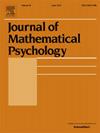特征与缠结:基于缠结的聚类分析五大范式
IF 1.5
4区 心理学
Q2 MATHEMATICS, INTERDISCIPLINARY APPLICATIONS
引用次数: 0
摘要
利用最近发展的缠结数学理论,我们通过一种新的、数学上严谨的定量方法,重新评估五因素模型在人格测试中应用的数学基础。我们的发现广泛地证实了当前测试的有效性,但也表明可以从现有数据中提取更详细的信息。我们发现,五大特征出现在不同的审查水平上。有些已经在我们的工具中以粗糙的分辨率出现,而其他的还不能被识别,而在这些可以被识别和区分的分辨率上,一些以前的特征不再可见,而是分裂成更精细的特征或完全分解。我们还发现了这些测试中五个目标之外的特征。这些特征包括将五大特征中的两种或两种以上结合起来的更一般的特征,以及对其中一些特征进行细化的更具体的特征。我们所有的分析都是结构性的和定量的,因此在明确定义的数学术语中是严格的。由于缠结一旦计算出来,就可以用很少的明确陈述来简洁地描述所使用的测试问题,我们的发现也直接开放给心理学专家解释。缠结分析可以类似地应用于心理学的其他主题。我们的论文的目的是作为什么可能的第一个指示。本文章由计算机程序翻译,如有差异,请以英文原文为准。
Traits and tangles: An analysis of the Big Five paradigm by tangle-based clustering
Using the recently developed mathematical theory of tangles, we re-assess the mathematical foundations for applications of the five factor model in personality tests by a new, mathematically rigorous, quantitative method. Our findings broadly confirm the validity of current tests, but also show that more detailed information can be extracted from existing data.
We found that the big five traits appear at different levels of scrutiny. Some already emerge at a coarse resolution of our tools at which others cannot yet be discerned, while at a resolution where these can be discerned, and distinguished, some of the former traits are no longer visible but have split into more refined traits or disintegrated altogether.
We also identified traits other than the five targeted in those tests. These include more general traits combining two or more of the big five, as well as more specific traits refining some of them.
All our analysis is structural and quantitative, and thus rigorous in explicitly defined mathematical terms. Since tangles, once computed, can be described concisely in terms of very few explicit statements referring only to the test questions used, our findings are also directly open to interpretation by experts in psychology.
Tangle analysis can be applied similarly to other topics in psychology. Our paper is intended to serve as a first indication of what may be possible.
求助全文
通过发布文献求助,成功后即可免费获取论文全文。
去求助
来源期刊

Journal of Mathematical Psychology
医学-数学跨学科应用
CiteScore
3.70
自引率
11.10%
发文量
37
审稿时长
20.2 weeks
期刊介绍:
The Journal of Mathematical Psychology includes articles, monographs and reviews, notes and commentaries, and book reviews in all areas of mathematical psychology. Empirical and theoretical contributions are equally welcome.
Areas of special interest include, but are not limited to, fundamental measurement and psychological process models, such as those based upon neural network or information processing concepts. A partial listing of substantive areas covered include sensation and perception, psychophysics, learning and memory, problem solving, judgment and decision-making, and motivation.
The Journal of Mathematical Psychology is affiliated with the Society for Mathematical Psychology.
Research Areas include:
• Models for sensation and perception, learning, memory and thinking
• Fundamental measurement and scaling
• Decision making
• Neural modeling and networks
• Psychophysics and signal detection
• Neuropsychological theories
• Psycholinguistics
• Motivational dynamics
• Animal behavior
• Psychometric theory
 求助内容:
求助内容: 应助结果提醒方式:
应助结果提醒方式:


